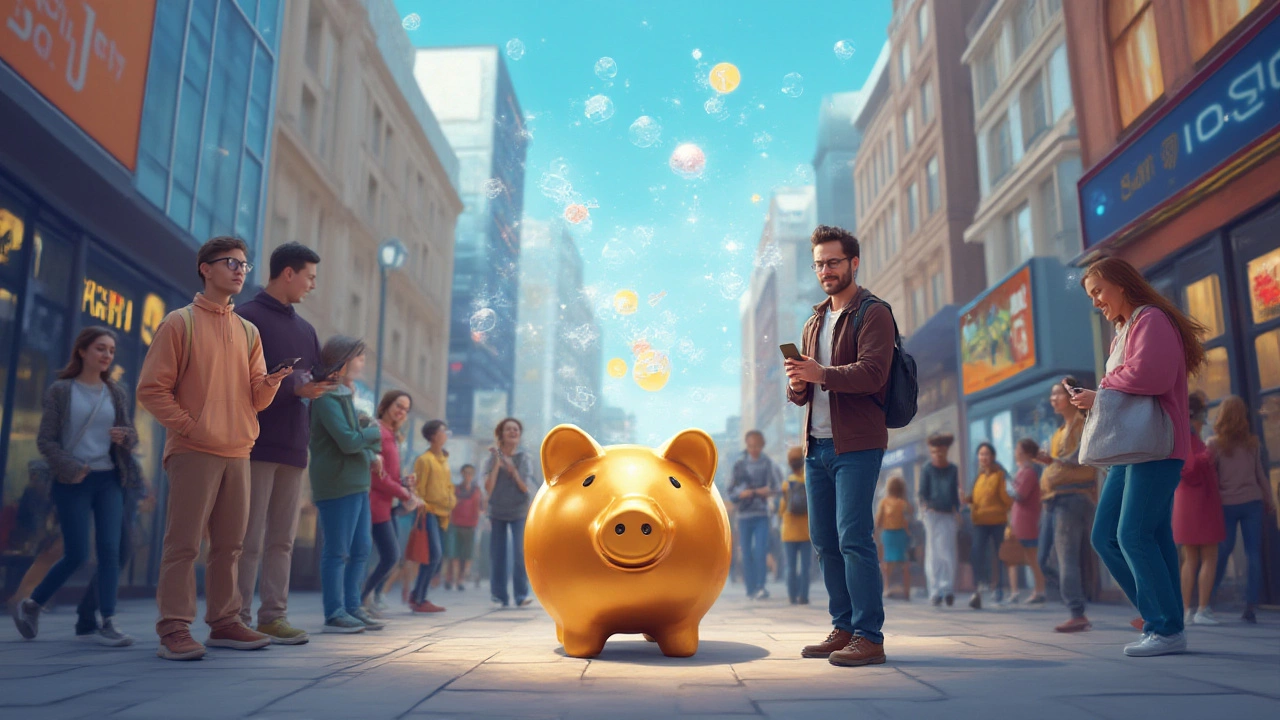Banks Offering 7% Savings Account Interest: Real Options and Top Alternatives in 2025
 Jul, 29 2025
Jul, 29 2025
Imagine you wake up and spot a 7% savings interest ad flashing in your inbox. Feels insane, right? If you grew up post-2008 crash, you’re used to savings accounts offering barely enough interest to buy a cup of coffee in a year. Now you’re curious, maybe even a little skeptical—can you really score 7% just by parking your money in a bank account?
The Truth About 7% Savings Account Offers in 2025
Let’s cut to it: very few banks offer a flat 7% interest rate on an ordinary savings account in 2025, at least not in Canada, the US, or the UK. When you see 7%, it usually comes attached to a lot of fine print. The headline number may be real, but it’s often limited to a certain dollar amount, set for a short introduction period, or linked to extra requirements like monthly deposits or bundled bank products. Some neobanks and fintechs dangle high rates to lure new customers, hoping you’ll stick with them once the terms sober up.
Here’s the landscape: In June 2025, the average standard savings account in Canada pays around 2.4% according to Ratehub, with the highest rates from specialty online banks touching 3.6%. In the US, high-yield accounts have nudged into the 4-5% range. That 7% number is usually a special promo, and the conditions will test your patience—and maybe your common sense. In May, a small Toronto neobank called WinPlus attracted headlines for touting "up to 7%": under $1,000, for 90 days, provided you also set up direct payroll deposits. Not exactly a life-changing windfall, but the marketing works.
If you’re reading this after someone forwarded you an offer or TikTok tip, make sure to check the bank’s real rate sheet. Don’t get caught by common traps:
- Balance Caps: If the 7% only applies to your first $1,000, anything above that drops to standard, boring interest rates.
- Promo Periods: Does that 7% last three months, and then sink to 1%? Often, yes.
- Bundled Products: You might need a chequing account, a credit card, or even an investment account to qualify.
- Geographic Restrictions: Some flashy digital banks are US-only, or even state-specific. Read the fine print.
Banks are counting on you to see the big bold number, jump on board, and go on autopilot. Once that promo ends, they’re betting you’ll stick around for convenience. Let’s face it, most people don’t move savings around every three months.
Specialized High-Interest Savings Accounts and Neobank Tactics
Splashy interest promos are mostly the domain of neobanks—those app-based challengers to the Big Five banks. Think EQ Bank, Neo Financial, Koho, or the American names like Current and SoFi. These banks keep costs down with no physical branches and target younger, digitally savvy savers. They use high-interest rates as bait. What’s clever is that, while 7% grabs attention, the average actual return is lower due to all the special conditions.
Take Neo Money’s offer from April 2025: "Get up to 6.75% on savings!" But here’s the fine print: you need to use their prepaid card for at least $150 in monthly purchases, and the high rate only applies to the first $5,000. Balances over that get 2.3%. The moment you slack off, your interest rate drops too. Upstart banks count on people missing one of the many small hurdles buried in the rules.
US fintech would love Canadian-style deposit insurance, but in Canada, CDIC only protects eligible deposits at member banks—another wrinkle to check out before sending your cash. Crypto apps sometimes tout outrageous “savings” rates, insisting your funds are "safe," but these returns are speculative and come with crypto market risks—not real banking guarantees. Don’t get fooled by blurred lines.
Let’s take a look at a quick table of a few actual high-yield offers in North America:
| Bank/App | Interest Rate | Balance Limit | Promo Duration | Special Requirements |
|---|---|---|---|---|
| Neo Money (Canada) | 6.75%* | $5,000 | 3 months | Spend $150/mo on Neo card |
| WinPlus (Canada) | 7% | $1,000 | 90 days | Payroll direct deposit required |
| Current (US) | 4.00% | $6,000 | Ongoing | No promo, but must use app |
| SoFi (US) | 5.30% | None | Ongoing | Direct deposit to qualify |
| EQ Bank (Canada) | 3.00% | None | Ongoing | No special requirements |
*For promotional period only; drops after 3 months
Bottom line? If you want that 7%, watch every line of the terms—not just the headline. And plan ahead for what happens when the promo rate vanishes.

How to Actually Boost Your Savings Returns (Without Chasing Gimmicks)
If you’re serious about building savings, it pays to look beyond the flashiest promo. The real winners are people who outsmart the bank’s marketing by stacking a few strategies. Here are some rock-solid ways to get the best net return on your emergency fund or major savings goal:
- Mix and Match: Don’t be afraid to split your cash. Use one account for promo-rate cash (up to the cap), and another reliable account for the rest. It takes a little spreadsheeting, but you’ll squeeze more out of your money.
- Watch the Fees: Read all disclosures. Some high-promo-rate accounts come with surprise fees for transfers, inactivity, or even just "premium features" after the intro period. Any fee larger than a cup of coffee will destroy your interest gains.
- Calendar the Promo Expiry: Set a reminder on your phone for when your high-rate promo ends. The “set it and forget it” crowd ends up back at a 1% interest rate far too often. Shop around before the new lower rate kicks in.
- Leverage TFSA/ISA Benefits: In Canada, stack your high-rate account inside a Tax-Free Savings Account (TFSA) so your interest stays out of the CRA’s hands. In the UK, stick to Individual Savings Accounts (ISAs) for the same reason. That way, every dollar of interest makes it to your pocket.
- Experiment with GICs or CDs: If you can lock away part of your cash, guaranteed investment certificates or certificates of deposit often pay more than a savings account, especially at oddball digital banks or credit unions. But keep enough cash liquid for real emergencies.
Curious about how small shifts make a difference? Plugging $1,000 into a 3% account versus a 7% account for a year is a difference of $40—not life changing, but if you stack multiple small promos and keep moving your cash, you can beat inflation or at least keep a steady trickle of free money flowing in.
Hidden Dangers and Fine Print to Watch For
Just because you see “7%” don’t let the dopamine hit cloud your judgement. The banks aren’t giving money away for free—they expect to profit. The most common catches aren’t always the obvious ones. For example, some promo accounts automatically convert to low-rate savings or even non-interest chequing once the intro period ends. You could wake up earning less than 0.1% by accident. Others tie the high rate to behaviour: you have to maintain a certain balance, or make a set number of debit transactions per month, and one misstep will forfeit the 7%.
Consider taxation as well. In Canada, interest from savings accounts (outside of a TFSA) gets taxed at your top marginal rate. High interest can mean a springtime tax headache—factor in the real after-tax return before jumping in. US readers with high-yield accounts face a similar issue, especially if your earnings push you into a higher tax bracket. For the crypto crowd, “savings” accounts promising high yields often don’t come with government-backed deposit insurance and may carry hidden market risks far beyond what any traditional account would pose.
Here are some lesser-known pain points:
- Credit Impact: Oddly, some fintechs or online banks may run a hard credit inquiry when you open an account—especially if it’s bundled with a card. Not common, but worth checking.
- Transfer Limits and Delays: Some online banks limit daily e-transfers or cause delays when moving money between accounts, which can be a real pain if you need emergency funds fast.
- Currency Conversion Fees: If you use a USD-based account as a Canadian, or vice versa, hidden conversion fees can eat up your interest earnings.
- Insurance Gaps: Not all flashy new banks are covered by deposit insurance (like CDIC in Canada or FDIC in the US). Don’t risk uninsured accounts for a slightly higher rate.
Careful research beats FOMO every time. Check the bank’s website, hunt around for honest user reviews, and if you can’t find a phone number or an address? Maybe save the risk for the blackjack table.

The Best Moves for Savvy Savers in 2025
So, where does all this leave you? The honest answer: grabbing a true, no-strings 7% savings rate probably isn’t happening in 2025—unless banks get desperate or rates skyrocket for a new crisis. Still, if you play the promo game smartly and combine a few proven moves, you can juice your cash to outpace inflation—without jumping through endless hoops.
Your best move is to use promo rates as part of a bigger plan. Sure, if you get a 3-month 7% deal on $1,000, take it—but set a hard reminder to shop around once it’s done. Keep the main bulk of your money somewhere with a competitive, stable rate (above 3% in Canada or 4% in the US right now), and keep an eye on new offers.
Always check that your money is protected by CDIC (or the equivalent insurance in your country), and don’t be afraid to use free budgeting tools or apps to track your accounts. Set up monthly calendar alerts to nudge you to move funds as rates change—this "interest surfing" makes you the winner, not the banks. If you have a far-off savings goal, explore laddering with short-term GICs to lock in higher yields while avoiding total illiquidity.
Lastly, if you spot a "7% savings account" headline, check three things: Is it for a real savings account, not a risky product? Are you covered by insurance if things go sideways? And are you happy with the terms after the shine wears off?
The best savers in 2025 pay attention, shop around, and never leave an extra dollar on the table. Skip the hype—find the facts, lock in real gains, and let the banks try their luck on someone else.
